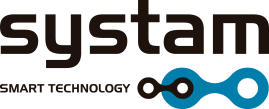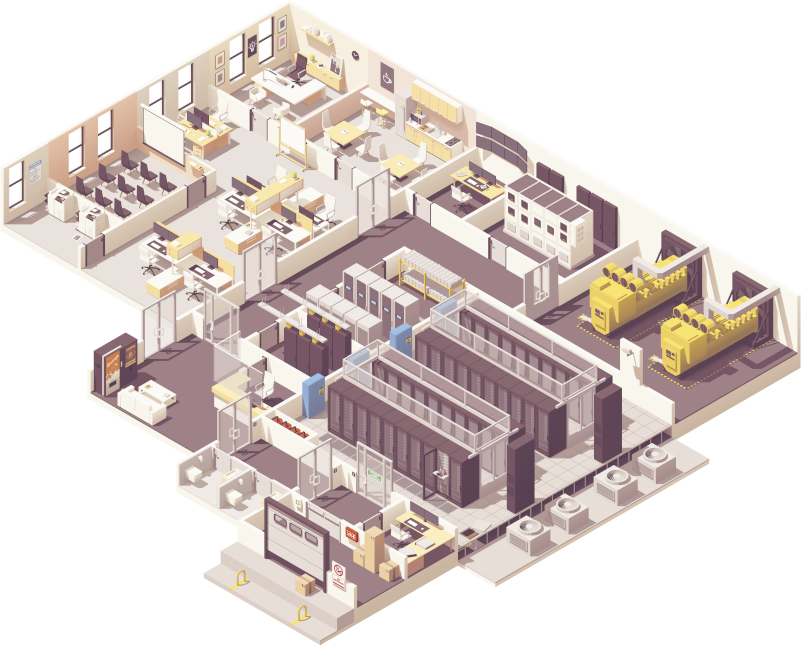

Close

SYSTAM has developed its own solution for Data Center Infrastructure Management (DCIM) with a scope that is not only limited to this type of installation but can be integrated into any type of infrastructure. It is an open solution, designed to be multi-owner and multi-site, following a hierarchical structure similar to the DCIM solutions developed by market leaders, but with a particular 360º vision which will allow for excellence in the global management and detailed study of the data obtained.
SYSTAM’s DCIM solution offers complete visibility, in real time, of all the assets that make up the infrastructure, being able to monitor all the attributes of space, energy, connectivity and status, as well as the support infrastructures. This tool makes it possible to develop scenarios (modelling changes before they go into production), analyse the impact on the infrastructure through current usage and improve management by analysing the data obtained.
The whole system works on the basis of a profile structure that allows access, visualisation, reporting and management from complex entities to specific alarms obtained from readings.

Create customised reports with the indicators that best define the quality, status, availability of services or the status of incidents and work orders, among others. Provide your managers with management information adapted and personalised to each department.
Centralised monitoring of all infrastructures in real time through SNMP, Modbus, BacNet, IPMI protocols or from external applications or measuring equipment such as (energy analysers, environmental sensors, water leaks, PLC, UPS, Groups, etc.).
Manage with Systam DCIM the assignment, prioritisation and escalation of incidents or service requests.
The integrated ITSM module is a complete Service Desk solution that allows you to simplify and optimise your operations with customers and users of your Data Centre, increase your productivity and benefit from industry best practices.
Systam DCIM ITSM provides you with a centralised tool from which to manage incidents and service requests directed to your support department. It allows you to open tickets to customers, users, operators, technical staff, imported from other applications or automatic, establish priorities, assign technical staff to the resolution of incidents, plan interventions and automatically keep your users permanently informed about the status of their request. Complete ITIL cycle in the resolution, documentation and closure of incidents and service requests that concludes with user satisfaction surveys on the level of service received.
The Systam DCIM DB allows the management of technical, working and contractual documentation.
Data Centre users and administrators can find the solution to problems in the knowledge database as there are often recurring incidents that do not require technical intervention beyond the first level to resolve. The knowledge database module is fed from tickets and information from the ITIL CMDB of assets, being able to incorporate any electronic file, image and/or link. The data is processed using a search engine that allows filtering by type of incident or asset. The security associated with each query can be defined at user level.
With Systam DCIM you can distribute the costs of Service Desk, Help Desk, technical support, hosting, etc., between departments within your organisation and between your customers. Allocate to each cost centre your IT infrastructure expenditure, both software and hardware. Automatically export the information to your ERP.
Manage contracts with your suppliers centrally and evaluate the quality of the service provided in real time. Assign maintenance contracts in any format (pdf, word) with suppliers to your assets, indicating the main variables (response times, schedules, coverage, etc.). Manage renewals with Systam and monitor the SLAs agreed with your suppliers. In addition, Systam DCIM allows you to agree internal SLA levels by asset or group of assets.
Automatically manage the assignment and prioritisation of tasks for your technical staff. Balance workloads and classify them by level of expertise.
Systam DCIM allows the definition of maintenance tasks, their association to assets and their subsequent planning, allowing the definition of the periodicity of the tasks, the associated procedures, the technical staff required for each intervention, the components, the work tools and the necessary safety equipment. The tickets associated with the tasks are automatically generated so that they can be properly planned and assigned.
The work order module is a complete ticketing solution that allows you to manage, prioritise and escalate Data Centre incidents or service requirements, increasing effectiveness by optimising tasks through industry best practices.
Geolocation of infrastructures and drill-down to various levels of assets on Autocad® and Visio® drawings, being able to access the properties of each asset on the diagram or drawing itself.
Plan and optimise the use of your data centre’s physical space, cabins and racks. Find the best location for your equipment based on space availability and requirements (redundancy, network connections, power needs). Proactively analyse the impact of any location changes before they occur.
The incorporation of alerts triggered from IP video cameras can generate events or tasks accompanied by the image that generates the alert for better identification and resolution of the problem, even if it is a thermographic image.
The automation of events or alarms is done with a simple configuration of the optimal thresholds of each variable, connected either by SNMP, ModBusIP – RS485/232, BacNet, IPMI protocols. This direct connectivity provides efficient management by being able to send SMS or e-mails to the groups of users involved in the possible resolution of the event, escalating if necessary to other management or control environments.
In the field of energy efficiency, Systam DCIM allows you to manage improvement plans with a substantial reduction in operating costs, as well as to break down energy consumption and costs, from a location, to the asset level, through departments and areas, obtaining high levels of ROI.
Energy efficiency management of data centres is increasingly becoming a key aspect of data centre management. Energy costs are rising and the amount of energy consumed is increasing due to increased data processing needs in general, more power and greater storage capacity due to the increased density of information systems. Higher power consumption requirements mean higher heat dissipation and higher air-conditioning needs.
Energy management through PUE indicators such as the DCIE allows us to optimise energy management and to be able to relate electricity consumption with WUE water consumption and CO2 emissions generated with the CUE indicator.
Remote DC connectivity is achieved through the “Systam Gateways” or SCGs, which act as the system’s front-office. These are responsible for sending to the central (back-office) all the data to be monitored from its assets, allowing multiple management of different Data Centres simultaneously, reliably and highly securely through VPN communications.
Systam DCIM includes the unique ability to view the entire power supply chain from mains to rack through a single line diagram. This industry-first capability allows users to easily document the entire power system, view real-time capacity utilisation and forecast power consumption, improving business continuity and reducing operational costs. By knowing their current capacity and having the ability to predict future needs, users can more accurately plan their capacity expansions. When users know exactly which racks or devices will be affected by any power system failures or scheduled maintenance, they can identify and troubleshoot potential problems before they cause a power outage. In addition, the module allows users to better plan power maintenance and assess risks.